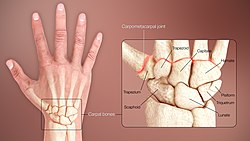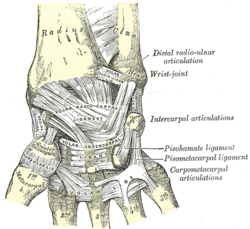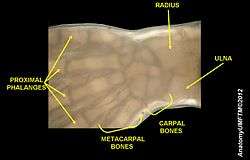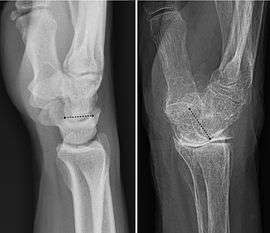Wrist
In human anatomy, the wrist is variously defined as 1) the carpus or carpal bones, the complex of eight bones forming the proximal skeletal segment of the hand;[1][2] (2) the wrist joint or radiocarpal joint, the joint between the radius and the carpus [2] and (3) the anatomical region surrounding the carpus including the distal parts of the bones of the forearm and the proximal parts of the metacarpus or five metacarpal bones and the series of joints between these bones, thus referred to as wrist joints.[3][4] This region also includes the carpal tunnel, the anatomical snuff box, bracelet lines, the flexor retinaculum, and the extensor retinaculum.
| Wrist | |
|---|---|
.jpeg) A human showing the wrist in the centre. | |
 The carpal bones, sometimes included in the definition of the wrist. | |
| Details | |
| Identifiers | |
| Latin | articulatio radiocarpalis |
| MeSH | D014953 |
| TA | A01.1.00.026 A03.5.11.002 |
| FMA | 24922 |
| Anatomical terminology | |
As a consequence of these various definitions, fractures to the carpal bones are referred to as carpal fractures, while fractures such as distal radius fracture are often considered fractures to the wrist.
Structure




The distal radioulnar joint is a pivot joint located between the bones of the forearm, the radius and ulna. Formed by the head of the ulna and the ulnar notch of the radius, this joint is separated from the radiocarpal joint by an articular disk lying between the radius and the styloid process of the ulna. The capsule of the joint is lax and extends from the inferior sacciform recess to the ulnar shaft. Together with the proximal radioulnar joint, the distal radioulnar joint permits pronation and supination. [5]
The radiocarpal joint or wrist joint is an ellipsoid joint formed by the radius and the articular disc proximally and the proximal row of carpal bones distally. The carpal bones on the ulnar side only make intermittent contact with the proximal side — the triquetrum only makes contact during ulnar abduction. The capsule, lax and un-branched, is thin on the dorsal side and can contain synovial folds. The capsule is continuous with the midcarpal joint and strengthened by numerous ligaments, including the palmar and dorsal radiocarpal ligaments, and the ulnar and radial collateral ligaments. [6]
The parts forming the radiocarpal joint are the lower end of the radius and under surface of the articular disk above; and the scaphoid, lunate, and triquetral bones below. The articular surface of the radius and the under surface of the articular disk form together a transversely elliptical concave surface, the receiving cavity. The superior articular surfaces of the scaphoid, lunate, and triquetrum form a smooth convex surface, the condyle, which is received into the concavity.
Carpal bones of the hand:
- Proximal: A=Scaphoid, B=Lunate, C=Triquetrum, D=Pisiform
- Distal: E=Trapezium, F=Trapezoid, G=Capitate, H=Hamate
In the hand proper a total of 13 bones form part of the wrist: eight carpal bones—scaphoid, lunate, triquetral, pisiform, trapezium, trapezoid, capitate, and hamate— and five metacarpal bones—the first, second, third, fourth, and fifth metacarpal bones.[7]
The midcarpal joint is the S-shaped joint space separating the proximal and distal rows of carpal bones. The intercarpal joints, between the bones of each row, are strengthened by the radiate carpal and pisohamate ligaments and the palmar, interosseous, and dorsal intercarpal ligaments. Some degree of mobility is possible between the bones of the proximal row while the bones of the distal row are connected to each other and to the metacarpal bones —at the carpometacarpal joints— by strong ligaments —the pisometacarpal and palmar and dorsal carpometacarpal ligament— that makes a functional entity of these bones. Additionally, the joints between the bases of the metacarpal bones —the intermetacarpal articulations— are strengthened by dorsal, interosseous, and palmar intermetacarpal ligaments. [6]
Articulations
The radiocarpal, intercarpal, midcarpal, carpometacarpal, and intermetacarpal joints often intercommunicate through a common synovial cavity. [8]
Articular Surfaces
It has two articular surfaces named, proximal and distal articular surface. The proximal articular surface is made up of lower end of radius and triangular articular disc of the inferior radio-ulnar joint. On the other hand, the distal articular surface is made up of proximal surfaces of the scaphoid, triquetral and lunate bones.[9]

Function
Movement
The extrinsic hand muscles are located in the forearm where their bellies form the proximal fleshy roundness. When contracted, most of the tendons of these muscles are prevented from standing up like taut bowstrings around the wrist by passing under the flexor retinaculum on the palmar side and the extensor retinaculum on the dorsal side. On the palmar side the carpal bones form the carpal tunnel through which some of the flexor tendons pass in tendon sheaths that enable them to slide back and forth through the narrow passageway (see carpal tunnel syndrome). [10]
Starting from the mid-position of the hand, the movements permitted in the wrist proper are (muscles in order of importance):[11][12]
- Marginal movements: radial deviation (abduction, movement towards the thumb) and ulnar deviation (adduction, movement towards the little finger). These movements take place about a dorsopalmar axis (back to front) at the radiocarpal and midcarpal joints passing through the capitate bone.
- Movements in the plane of the hand: flexion (palmar flexion, tilting towards the palm) and extension (dorsiflexion, tilting towards the back of the hand). These movements take place through a transverse axis passing through the capitate bone. Palmar flexion is the most powerful of these movements because the flexors, especially the finger flexors, are considerably stronger than the extensors.
- Extension: extensor digitorum, extensor carpi radialis longus, extensor carpi radialis brevis, extensor indicis, extensor pollicis longus, extensor digiti minimi, extensor carpi ulnaris
- Palmar flexion: flexor digitorum superficialis, flexor digitorum profundus, flexor carpi ulnaris, flexor pollicis longus, flexor carpi radialis, abductor pollicis longus
- Intermediate or combined movements
However, movements at the wrist can not be properly described without including movements in the distal radioulnar joint in which the rotary actions of supination and pronation occur and this joint is therefore normally regarded as part of the wrist. [13]
Clinical significance

Wrist pain has a number of causes, including carpal tunnel syndrome, ganglial cyst, and osteoarthritis. Tests such as Phalen's test involve palmarflexion at the wrist.
The hand may be deviated at the wrist in some conditions, such as rheumatoid arthritis.
Ossification of the bones around the wrist is one indicator used in taking a bone age.
A wrist fracture usually means a fracture of the distal radius.
History
Etymology
The English word "wrist" is etymologically derived from the ancient German word wristiz from which are derived modern German rist ("instep", "wrist") and modern Swedish vrist ("instep", "ankle"). The base writh- and its variants are associated with Old English words "wreath", "wrest", and "writhe". The wr- sound of this base seems originally to have been symbolic of the action of twisting. [15]
See also
- Brunelli procedure, related to instability in the wrist, caused by a torn scapholunate ligament.
- Knuckle-walking, a kind of quadrupedal locomotion involving wrist bone specialization
- Wristlocks use movement extremes of the wrist for martial applications.
Additional images
 Wrist joint. Deep dissection. Posterior view.
Wrist joint. Deep dissection. Posterior view. Wrist joint. Deep dissection. Posterior view.
Wrist joint. Deep dissection. Posterior view.- Wrist joint. Deep dissection.Anterior, palmar, view.
- Wrist joint. Deep dissection.Anterior, palmar, view.
Notes
- Behnke 2006, p. 76. "The wrist contains eight bones, roughly aligned in two rows, known as the carpal bones."
- Moore 2006, p. 485. "The wrist (carpus), the proximal segment of the hand, is a complex of eight carpal bones. The carpus articulates proximally with the forearm at the wrist joint and distally with the five metacarpals. The joints formed by the carpus include the wrist (radiocarpal joint), intercarpal, carpometacarpal and intermetacarpal joints. Augmenting movement at the wrist joint, the rows of carpals glide on each other [...] "
- Behnke 2006, p. 77. "With the large number of bones composing the wrist (ulna, radius, eight carpas, and five metacarpals), it makes sense that there are many, many joints that make up the structure known as the wrist."
- Baratz 1999, p. 391. "The wrist joint is composed of not only the radiocarpal and distal radioulnar joints but also the intercarpal articulations."
- Platzer 2004, p. 122
- Platzer 2004, p. 130
- Platzer 2004, pp. 126–129
- Isenberg 2004, p. 87
- "Wrist Joint".
- Saladin, 2003, pp. 361, 365
- Platzer 2004, p. 132
- Platzer 2004, p. 172
- Kingston 2000, pp. 126–127
- Döring AC, Overbeek CL, Teunis T, Becker SJ, Ring D (2016). "A Slightly Dorsally Tilted Lunate on MRI can be Considered Normal". Arch Bone Jt Surg. 4 (4): 348–352. PMC 5100451. PMID 27847848.
- "Hand Etymology". American Society for Surgery of the Hand. Retrieved August 2009. Check date values in:
|accessdate=(help)
References
- Baratz, Mark; Watson, Anthony D.; Imbriglia, Joseph E. (1999). Orthopaedic surgery: the essentials. Thieme. ISBN 0-86577-779-9.
- Behnke, Robert S. (2006). Kinetic anatomy. Human Kinetics. ISBN 0-7360-5909-1.
- Isenberg, David Alan; Maddison, Peter; Woo, Patricia (2004). Oxford textbook of rheumatology. Oxford University Press. ISBN 0-19-850948-0.
- Kingston, Bernard (2000). Understanding joints: a practical guide to their structure and function. Nelson Thornes. ISBN 0-7487-5399-0.
- Moore, Keith L.; Agur, A. M. R. (2006). Essential clinical anatomy. Lippincott Williams & Wilkins. ISBN 0-7817-6274-X.
- Platzer, Werner (2004). Color Atlas of Human Anatomy, Vol. 1: Locomotor System (5th ed.). Thieme. ISBN 3-13-533305-1.
- Saladin, Kenneth S. (2003). Anatomy & Physiology: The Unity of Form and Function (3rd ed.). McGraw-Hill.
External links
| Wikimedia Commons has media related to Wrists. |
| Look up wrist in Wiktionary, the free dictionary. |